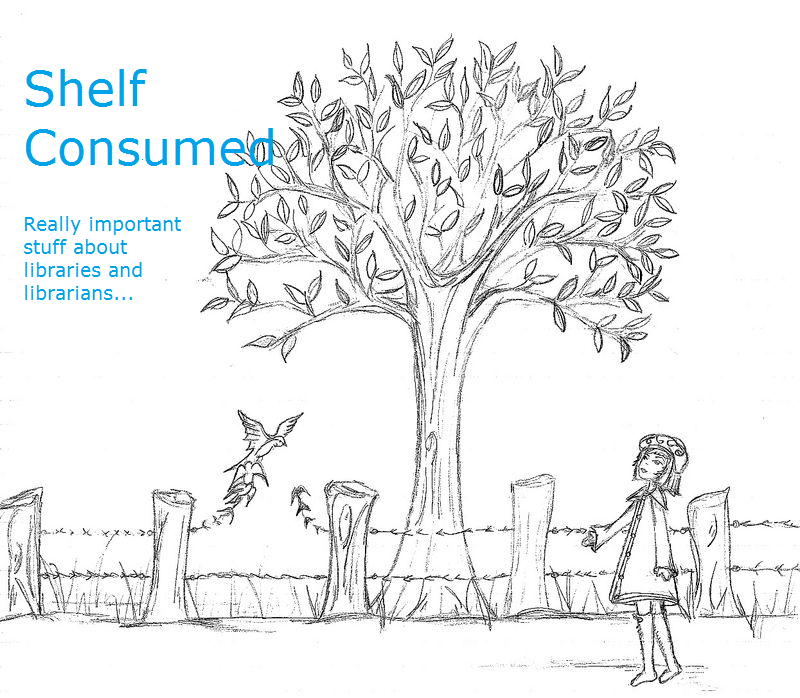Below is a one-hour presentation on research that you're welcome to use with your faculty if you'd like. Questions are welcome!
Credits:
PIL InfoLit Dialog, No. 3: Frustrations
Eli Pariser: Beware online "filter bubbles"
7 Billion, National Geographic Magazine
Tuesday, November 22, 2011
Sunday, November 20, 2011
Get your read on, y'all!
It's a great time of year in Texas for finding good books. Over the past year, committees of librarians across the state have been reading the best in newly-published books in order to form the Texas 2 x 2, Bluebonnet, Lone Star, Tayshas, and Maverick reading lists.
Here's a short guide to these lists designed to promote pleasure reading:
Texas 2 x 2 list: 2 year-olds through second grade
(new list not released at the time of this post)
Bluebonnet: third through sixth grades
Lone Star: sixth through eighth grades
Tayshas: ninth through twelfth grades
Maverick: graphic novels for grades sixth through twelve.
Happy reading, y'all.
Sunday, November 13, 2011
You can't make this stuff up
Last week eighth graders were in the library looking for biographies for an upcoming project.
"Do you have a book about Anne Frank," one girl asked? "You know, the girl who couldn't see or hear or talk?"
Another student wanted help finding a biography "about someone in World War II." I showed him several, but not finding any he liked, he asked, "What about World War III?"
Sunday, November 6, 2011
Deconstructing research
For the first time in several years, I'm a practicing librarian again, which is great. One thing it's done is allow me to see how things are from a student's perspective.
I've realized that kids, even smart, tech-savvy high schoolers, need the research process broken down into steps. It's not enough to throw out a six-step process, show them how to access the databases, and walk around to see if they need help.
Below is a work in progress called Deconstructing the Research Process that I've used with good success for the last couple of classes who have researched in the library. I gave every student a copy with the home use database passwords on the back and very briefly walked the kids through the process, giving examples that applied to their research.
In a perfect world, kids would choose their own topics and this handout would reflect that ownership. It would also be better for the kids for this overview to be chunked into smaller sections and presented at the point of need.
Your comments, questions, and suggestions are welcome! Because the format doesn't hold well here, I'd be happy to email this to you in a Word doc to use with your students.
Deconstructing the Research Process
1. Understand your task—how do I get started?
a. Set deadlines for yourself. When is the project due?
b. Find out what product you will create. Is there a rubric or project sheet to consult?
c. Find out how you will cite your sources.
d. Know what your responsibility is if you are working with a partner or group.
e. Ask how much detail will be needed. What is the scope of the project?
2. Plan for your topic—what do I need/want to learn?
a. Have a clear understanding of who/what your topic is.
b. Gain an overview by reading about your topic in your textbook or on Wikipedia, for example.
c. Look up unfamiliar words while reading the overview.
d. Jot down keywords while you read.
e. Realize why your topic is important.
3. Search for information—where do I find information? (Ask your librarian for tips!)
a. Know the number and type of sources required.
i. Reference or informational books vs. encyclopedia
ii. Database vs. internet
iii. Journal vs. magazine
b. Ask if a specific organizational tool (notecards, graphic organizer, etc.) is required for note taking.
c. Plan search terms by looking at the keywords you jotted down earlier.
d. Search multiple sources of information.
4. Use the information you find—what do I do with the information?
a. Take notes as you search, finishing with one source before moving to the next one.
b. Organize your notes by subtopic, not by source.
c. Write down words and phrases only—this is key to avoiding plagiarism.
d. Collect necessary information to cite your sources.
e. Keep checking what you’ve been asked to find—are you on track?
f. Consider all possible sources of information.
g. Try other keywords and/or other sources until you find all you need.
5. Create a product using the information—how do I present the information?
a. Consult your project sheet again.
i. Who is your audience? What is your purpose?
ii. Double check the requirements for your project.
b. Organize and sequence pertinent information.
i. Discard information that is not relevant.
ii. Set aside information that may not be needed.
c. Cite sources correctly using required format.
d. Use high standards of quality to create your product.
6. Reflect on your process and product—what can I improve?
a. Revise and edit.
b. Get input as needed.
c. Proofread.
d. Finish your product and then publish, present, and share.
For next time, what would you do differently? What have you learned?
Subscribe to:
Posts (Atom)



